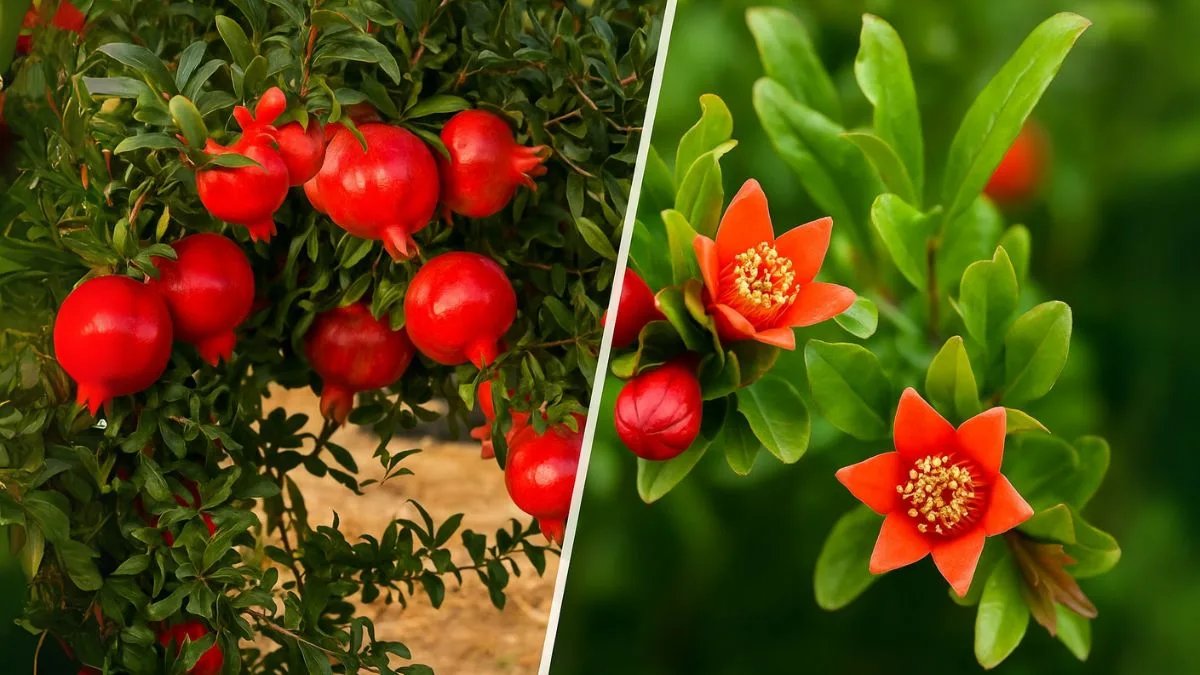Few fruits have captured the imagination of gardeners and food lovers quite like the pomegranate plant. Known as a symbol of prosperity, abundance, and health, this vibrant fruit has a rich history dating back thousands of years. Beyond its symbolic meaning, the plant itself is an excellent addition to home gardens, patios, and orchards.
The pomegranate is one of the commercially important fruit crops, cultivated widely across the globe. What makes it so special is its ability to thrive in diverse climates, while producing those jewel-like seeds packed with flavor and nutrition.
Plant Profile: What You Need to Know

The pomegranate plant is a woody, deciduous, perennial shrub or tree, making it highly versatile in the garden. Depending on the conditions, it can be grown as a deciduous or semi-evergreen shrub or small tree, typically 5–10 meters tall.
Key Features:
- Glossy green leaves that turn golden before falling in colder seasons.
- Vibrant orange-red flowers that add ornamental beauty.
- Distinctive round fruits filled with ruby-red seeds.
This dual-purpose nature — ornamental and fruit-bearing — makes it especially popular among home gardeners in Canada, the USA, and beyond.
Ideal Growing Conditions
Like most fruit-bearing plants, the pomegranate thrives when given the right environment.
- Sunlight: The plant thrives in sunny spots and well-drained soil, so choose a bright location in your garden or near a patio.
- Soil: For optimal results, pomegranates need deep, slightly acidic, moist soil with good drainage. Sandy loam soils are considered ideal.
- Climate: They do well in warm climates, though certain cold-hardy varieties adapt to temperate zones with winter protection.
If you live in a region with harsh winters, consider container growing. This way, you can move the plant indoors when temperatures drop.
Also Read: Turn a Single Plums Pit into a Thriving Tree—Here’s the Secret
Planting and Propagation
When you plant pomegranate, you can choose between seeds or cuttings. While seeds are easy to start with, cuttings tend to produce fruit faster and stay true to the parent variety.
Steps for planting:
- Prepare the soil by loosening it and enriching it with compost.
- Dig a hole twice as wide as the root ball.
- Plant it at the same depth as in its nursery pot.
- Water thoroughly after planting to settle the soil.
Over time, the plant establishes strong roots and adapts well to its location.
Care and Maintenance Tips
Although resilient, the pomegranate plant benefits from consistent care.
- Watering: Regular watering during the first few years is crucial. Mature plants are drought-tolerant but still produce better fruits with consistent moisture.
- Pruning: Trim dead or overcrowded branches to allow airflow and sunlight.
- Fertilizing: Apply a balanced fertilizer in spring and mid-summer to support growth and fruiting.
- Pests/Diseases: The plant is relatively pest-resistant, though occasional aphids or fungal issues may arise. Neem oil or organic sprays usually keep them under control.
With proper onion care and maintenance tips-style consistency (structured watering, feeding, and pruning routines), your plant will reward you with abundant harvests.
Also Read: From Root to Remedy: How to Grow Turmeric Indoors Easily
Benefits of Growing Pomegranate
Why should you grow a pomegranate plant at home? The list is long:
- Nutritional Value: Rich in antioxidants, vitamins, and minerals.
- Cultural Appeal: Symbolizes abundance and fertility.
- Ornamental Beauty: Glossy leaves, striking flowers, and colorful fruits.
- Low Maintenance: Hardy once established.
For families in Canada and the USA, it’s both a conversation starter and a delicious source of homegrown fruit.
Personal Experience
When I planted my first pomegranate tree a few years ago, I was amazed at how quickly it adapted to my garden. The glossy foliage stayed vibrant even in dry spells, and within three years, it produced its first handful of fruits. The satisfaction of opening a freshly picked pomegranate from my own yard was incomparable. That experience made me realize why this plant is treasured worldwide.
Quick Reference Table
Feature |
Details |
Plant Type |
Woody, deciduous, perennial shrub or tree |
Height |
Deciduous or semi-evergreen shrub or small tree, typically 5–10 meters tall |
Soil |
Deep, slightly acidic, moist soil |
Sunlight |
Thrives in sunny spots and well-drained soil |
Importance |
One of the commercially important fruit crops |
Also Read: Birds of Love: The Winged Symbols of Romance and Devotion
The pomegranate plant (Radermachera sinica) is more than just another fruit crop — it’s a symbol of life, prosperity, and beauty. Being an evergreen shrub or small tree that thrives in sunny spots and well-drained soil, it’s well-suited for gardens around the world. Remember, pomegranates need deep, slightly acidic, moist soil and consistent care, but the reward of homegrown fruit is truly worth the effort.
So, whether you’re in Canada, the USA, or anywhere across the globe, adding this timeless plant to your garden will bring both beauty and bounty for years to come.






